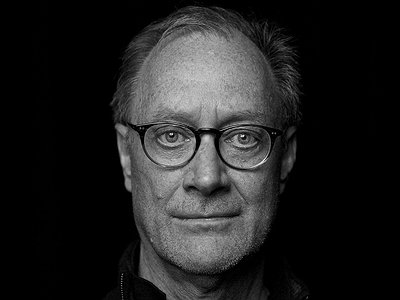Name: Douglas Knehans
Nationality: American
Occupation: Composer
Current Release: Unfinished Earth on Ablaze Records and NAXOS
Recommendations: Lamentation by Kehinde Wiley. I admired this artist well before the Obama portrait, which is not one of his best in my opinion. This guy is the real deal and I guess I feel sympathy because he too takes the past and repositions it, even resynthesizes it, to create profoundly beautiful, spectacularly crafted works that really speak on so many levels.
Website/Contact: If you enjoyed this interview with Douglas Knehans visit his website www.douglasknehans.com
When did you start composing - and what or who were your early passions and influences?
I started almost at the same time as I first became mildly proficient as a flute player. My first ‘work’ was an original cadenza to a Mozart flute concerto. My earliest influence was the music of JS Bach, especially the violin sonatas and partitas. This was followed by a deep interest in Shostakovich and Mahler and then more progressive 20th works.
For most artists, originality is first preceded by a phase of learning and, often, emulating others. What was this like for you? How would you describe your own development as an artist and the transition towards your own voice? What is the relationship between copying, learning and your own creativity?
It was stark for me, I had to learn, like all of us did in those days. A serial technique and compositional matrices for example. Upon graduating with my degree, I realized that this approach taught me little about controlling the compositional flow of anything other than pitch regulation. I began to set the expression-laden, imagistic poems of Sylvia Plath. The compositional language I had been taught faltered. So, from that point I began to teach myself through a kind of meta-synthesizing of past practices of composers like Beethoven, Brahms, Mahler and others with a kind of set-oriented organization and a Mahlerian/Stravinskian use of cellular blocks as part of an approach to forming spans of music. So, I would say the relationship between copying and my own style is one based on traditional practice, quite abstracted and meta-driven with large helpings of individually derived approaches to small and large-scale pitch organization.
What were some of the most important creative challenges when starting out as a composer and how have they changed over time?
I think when starting the real question is “How do I make Art?” As one matures I think this evolves into “How do I create Meaning?”
Tell us about your studio/work space, please. What were criteria when setting it up and how does this environment influence the creative process? How important, relatively speaking, are factors like mood, ergonomics, haptics and technology for you?
My studio has the usual things in it: desk, piano, computer, printer, stereo and a couple of pairs of reference speakers. The place is pretty stuffed with scores, books and CDs but my main work area looks out onto our back garden which is fairly expansively open to lots of trees, shrubs and attracts a lot of wildlife from chipmunks, deer to foxes and broad-tailed hawks. The open sky and large trees as well as these beautiful creatures that come in and out of our garden are just wonderfully calming to see as I think about and write music. Most of my recent music has much to do with the complex flow, design or expression of the natural world so looking out in to it has much to do with my process.
Could you take us through a day in your life, from a possible morning routine through to your work? Do you have a fixed schedule? How do music and other aspects of your life feed back into each other - do you separate them or instead try to make them blend seamlessly?
I live a complex but rewarding life. I am a composer, but also a composition professor at one of the top ten Conservatories in the US. I run my own record company as a director and producer focusing on new music of lesser known composers. I start my day with my usual six shots of espresso and breakfast, then I get down to the more mechanical things. Once I have “cleared the desk” of the most pressing of business tasks, these could be a mix of record company tasks, university and e-mails. I usually sit at the piano and look over the previous day’s work and start in on alterations/improvements to that work, leading back into extending into new sections on the work.
I figured out that I needed to finish each work day by not finishing a section of a work which allows for easy re-entry to the work the following day. I finish off the section knowing what I was going to do the previous day and this pulls me back into the work and allows for the next section to come most naturally.
There are many descriptions of the ideal state of mind for being creative. What is it like for you? What supports this ideal state of mind and what are distractions? Are there strategies to enter into this state more easily?
I like more the idea of writing at the kitchen table while everyone is milling around, talking and cooking a meal as I once read about Shostakovich. It can be usual for me to be writing while the television is on in the next room or my wife or son are practicing their instruments, or even doing work in airports or on planes and trains: necessity is the mother of invention and I need to write, so I make it work no matter what. I am good at blocking out external things. For me, the time I really need a little isolation and quiet is in the initial conception of a work and perhaps the generation of the initial materials of the work. Once these are established, I don’t need hermetically sealed silence or sanctified ideal situation in order to create.
Could you take me through the process of composing on the basis of one of your pieces that's particularly dear to you, please? Where did the ideas come from, how were they transformed in your mind, what did you start with and how do you refine these beginnings into the finished work of art?
It is impossible to chart this complex process with any pithy exactitude. I am pretty much a “top-down” composer. I think of the overall design and flow, both technically and expressively/dramatically. Once this is established things are quick for me. The establishment of a central idea or concept is important since these acts to inform decisions about design and expression. For example, my work Unfinished Earth, utilizes natural environmental elements such earth, water, cloud, mist, and wind as externalized metaphors for the complex internal worlds of thought, emotion and philosophy. The environment, with its terrifically varied expressions and combinations of elements, offers rich analogues to the endlessly varied and complexly informed inner worlds of the human condition. Unfinished Earth really was designed to reference two dimensions, the external one of the natural world and the internal one of human emotional and thought. The first movement Tempering, is about the formation of earth. However, this is also about how we as people continue to unfold new internal territories and emotional pathways formed through eruptive events. This was the central idea of the first movement of the work. This was followed through with a formal design of three expositions, followed by a terse development of ideas. Each exposition intensifies the ideas, and this finally erupts into a less controlled and less measured developmental flow. This idea is then scoped out technically in terms of structure, pitch collections, musical idea, length and general dramatic flow. Once the foreground material and intention are all decided or designed, it’s natural for me to flow these ideas through in what feels like an organic and connected way.
How do you make use of technology? In terms of the feedback mechanism between technology and creativity, what do humans excel at, what do machines excel at?
Machines excel at what humans get them to do. I think of technology as everything from pencil and paper, to piano and computers. I really do think of the computer as the contemporary version of the organ, flute, or piano. I use it as a tool, just as a pencil is used as a tool to initially write down ideas. There are elements of execution that computers can achieve and I like to pair that frequently with live instruments as in my monodrama for soprano, computer music surround diffusion, electric cello and video Backwards from Winter which will premier in New York City this May.



